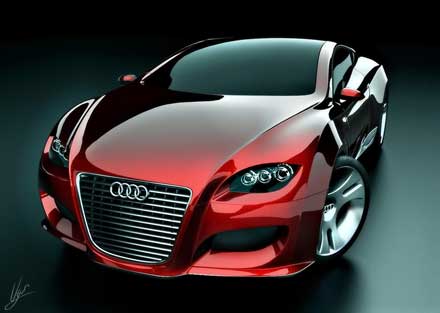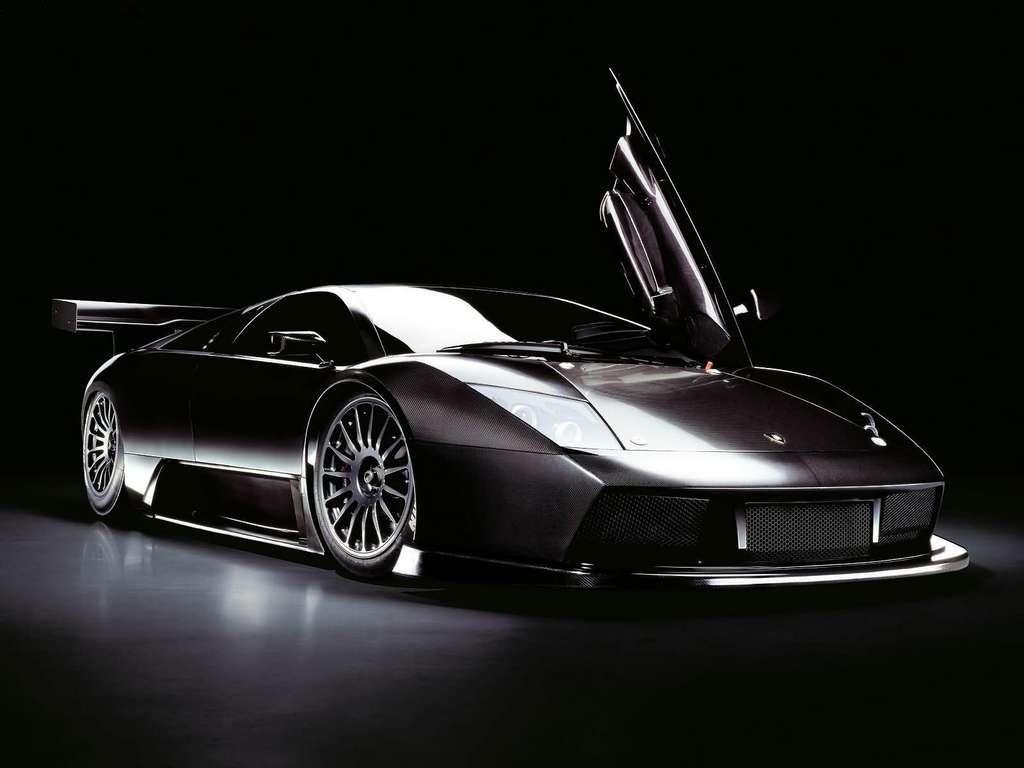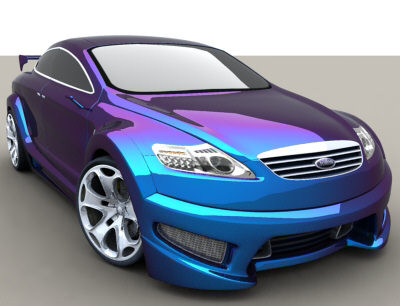 According to Seat, the Tribu Concept previews the design language of the next models to be launched by the Spanish company (Ibiza and Toledo). Moreover, it's the first model to be penned by Seat's new Chief Designer, Luc Donckerwolke since he came to the Spanish brand after holding the same position at Lamborghini. To be completely honest, we don't understand what the fuss is all about. In our eyes the Tribu features a 'crispier' or 'edgier' interpretation of Seat's current design language as previewed by the Salsa concept which led to the second generation
According to Seat, the Tribu Concept previews the design language of the next models to be launched by the Spanish company (Ibiza and Toledo). Moreover, it's the first model to be penned by Seat's new Chief Designer, Luc Donckerwolke since he came to the Spanish brand after holding the same position at Lamborghini. To be completely honest, we don't understand what the fuss is all about. In our eyes the Tribu features a 'crispier' or 'edgier' interpretation of Seat's current design language as previewed by the Salsa concept which led to the second generation 
















A glimpse of the future
A concept car that offers a preview of upcoming models
Three drive modes: Urban, Sport and Freerun
A tough, compact and truly sporty image
Frankfurt is the venue for the launch of a concept car which is very important to SEAT, as it represents a turning point in the future of the Spanish brand. Just as the Salsa prototype was the prelude to the SEAT Leon, the new Tribu demonstrates the design basis for the next models to be launched by SEAT.
Indeed, the new Tribu is the first model to be completely designed by the Spanish brand's Chief Designer, Luc Donckerwolke and his team, since he joined SEAT after holding the same position at Lamborghini. Straighter and well-defined shapes, combined with sharper lines, increase the surface tension of the components which make up the model's design, and mark a change from the current design of the SEAT models. The Tribu has a robust yet sporty look allied with great versatility. Comfortable interiors, filled with passenger comfort and technological features. And of course a high-performance diesel engine with excellent environmental compatibility.
That's what future SEAT models will be like, with this concept car giving us a sneak preview.
Creative force
The Tribu once again demonstrates SEAT's enormous potential to create and develop new models. Its design reflects the SEAT brand's genes and its 'auto emocion' slogan; this design is innovative, with a strikingly sporty character and great vitality. And even more importantly, this concept car is not just looking to be the star of the motor show: its also previews the design trends for future SEAT models.
This was the case in the past for the SEAT Salsa, a vehicle which received great acclaim when it was unveiled in 2000, and was the prototype for the design and compact architecture of the SEAT Leon and the Altea family of today.
The Tribu is the latest in a line of SEAT concept cars, and is suitable for both on-road and off-road driving.
Three spirits in just one car
The Tribu manages to reconcile the contrasting worlds of town and country. Indeed, it could be said to be a car which is designed just as much for the town as it is for the country.
Three very different modes are combined in the one body, with the driver able to select the mode of his or her choice at any time. Depending on whether Urban, Sport or Freerun mode is selected, the new SEAT concept car changes its technical parameters (engine management, suspension, transmission and so on) in order to adapt to the circumstances in which it is used.
As the name indicates, Urban drive mode is for driving in urban areas, and prioritises comfort and fuel economy, as well as emissions reduction. Sport mode can be selected for showing off the sheer power of the Tribu's engine, with the main technical parameters for this mode being performance and driving dynamics. Finally, when heading off-road, Freerun mode adjusts the engine, transmission and suspension, enabling the Tribu's 4x4 nature to shine through.
And the Tribu does not just adjust its parameters in line with the selected drive mode. It also adapts to information from the vehicle's instruments, and even in some cases to the interior configuration.
SEAT genes
The most striking feature when you get close to the new Tribu is the complete evolution that the concept car undergoes compared with the SEAT range to date. The innovative hatchback and the impressive 20'' wheels make us realise that we are looking at a SEAT of the next generation. Even the untrained eye will easily be able to spot characteristic elements of the brand genes in the prototype's sideline and the expressive front end.
The dynamic line, which is so characteristic of SEAT models, has evolved and reconfirms its presence on the vehicle, starting from the front section, above the headlights. If we consider the headlights to be the Tribu's eyes, the start of the sideline is its eyebrows. This strong front line continues above the front wheel arch along the side of the vehicle to the rear.
The new generation of SEAT models will undoubtedly be easy to recognise from any angle.
But this is where the similarities with any other SEAT models end.
A three-door model with compact and sporty looks
The new Tribu displays all the features of a true SUV, and like traditional four-wheel-drive vehicles, there is a clear separation in its outline between the body of the vehicle (the passenger compartment) and the wheels and fenders. In addition, its compact shape gives the Tribu a truly sporty feel. From a raised frontal position, its expressive headlights and front panel, combined with the overhanging wheel arches, give the Tribu the look of a single-seater racing car. And the Tribu's appearance does not flatter to deceive, as its off-road character, impressive ground clearance and its total four-wheel-drive system, make it an authentic off-roader.
We could even go as far as saying that the colour of the new concept car contributes to its off-roader look. The Tribu's metallic yellow paintwork makes it blend in with the ochre shades of rural tracks, contributing to the car's closeness with nature. As a special feature, the less exposed parts, such as the hood, are finished with a layer of shiny paint. Areas that would suffer more from the effects of minor bumps or the impact of stones are covered with matt paintwork.
The side section of the new Tribu contains numerous design features that enhance its sporty feel. In addition to the dynamic line which already characterises the current generation of SEAT models, it is worth highlighting the absence, to the naked eye at least, of a B pillar, which gives continuity along the length of the side section up to the front and rear windows. The compact and sporty shape of the Tribu is also emphasised by its three-door configuration, with the driver and passenger doors being large size, and, as a special feature, not having frames.
Although undeniably sporty, the Tribu does not forget that it is also a 4x4. Off-roader features, such as the roof rack, can be appreciated from the side. The roof rack itself is original, as it is incorporated into the body of the vehicle, which is extended upwards in order to provide space.
The integrated turn signals are a special feature of the door mirrors. These turn signals are located inside aluminium-coloured mouldings, featuring a trapezoidal shape which is the hallmark of this model.
Finally, as regards the side section of the prototype, the Tribu's door handles are worthy of a mention. When the vehicle is locked, the handles retract into the door. However, when the vehicle is being opened, the handles rotate on an axle, making them accessible.
The trapezoidal geometry of the front headlights, radiator grille and air intakes, as well as the new-look extended hexagonal shape of the grilles, give the Tribu a powerful, ultra-strong appearance. In the same way, the overhanging front and rear wheel arches add to the previously mentioned design features, giving the Tribu a sporty feel.
Viewed from the front, and from behind, the large yet compact bonnet stands out, and the windscreen also extends along the length of the vehicle's roof. In this way, the windscreen and the panoramic roof blend into one, allowing a maximum amount of light into the passenger compartment, which makes it ideal for enjoying the scenery.
On the rear section of the Tribu, the most striking feature when viewed with the naked eye is the lack of rear lights. The rear lights are in fact located behind the hatchback, and can only be seen when illuminated, when the brake lights, sidelights and indicators are activated. The latest technology is used both on the rear lights and the headlights, which are made up of LED lights, offering the best possible guarantee of seeing and being seen.
Innovative rear hatch
Another truly original design feature is the novel hatchback opening system. The system moves up along two rails and has two phases. In the first phase, the door only partially opens, enabling small items to be put in or taken out. In the second phase, the hatchback continues moving along its rails until it pivots onto the roof of the vehicle, constituting an example of harmonious integration into the body of the concept car.
The rear fog lights, meanwhile, just like the reversing light, are integrated onto the bumper. The two exhaust outlets are also located on the sides of the bumper. Another feature of the Tribu's sporty spirit is a small aluminium spoiler, matching other parts of the body such as the roof bars, the door handles and the mouldings, where the door mirror indicators are located.
The lower section of the front and rear bumpers is formed by mouldings in black, guaranteeing protection for the body when the new Tribu heads off-road.
This is also the case along the sides of the vehicle, with the lower section in the same material with the same purpose. However, viewed from the side, all eyes will be drawn to the impressive 20'' wheels, with 255/50 tyres. Their design features a striking trapezoidal shape which has already been mentioned in connection with the mirrors, and which is also evident in other elements both on the inside and outside of the vehicle, while the impressive brake discs can be seen through the wheels.
With the modernity and spaciousness of a loft
Once the doors of the new Tribu are opened, the first thing that will catch the eye is the interior concept, which is inspired by the colours, design, luminosity and proportions of a loft-type space, where spaciousness and modernity go hand-in-hand. The wide range of technical features which maximise comfort and convenience for the driver and passengers also stands out. And that is without mentioning the vehicle's excellent passenger and driver space, and the practical solutions that not only invite you to travel, but also to enjoy the journey.
The joint windscreen and panoramic roof bring the outside world into the Tribu. This feature also makes us feel that we are travelling in a vehicle which is much roomier than its actual dimensions would suggest.
With a four-seat interior configuration, we can see that the front seats are authentic bucket seats which boast ideal ergonomics and which feature height and fore-aft adjustment as well as having integrated seatbelts. The Tribu's front seats boast several special design features. In particular, they have their own independent air conditioning circuits. In addition, the air outlets for the rear seats are located on the back of the front seats.
These seats are separated by a central tunnel which can be used as an armrest or drinks holder, as well as offering practical storage space. Without quite being bucket seats, the rear seats also stand out due to their sports vehicle configuration, guaranteeing maximum lateral hold. The rear seats can also be folded down in order to create a totally flat space, thus increasing boot capacity.
Once in the driver's seat, we really notice a major qualitative improvement in terms of materials, as well as the design and technology.
Great emphasis has also been placed on driver and passenger space. The Tribu is not just about design: it is also a highly practical vehicle. Despite its compact shape and dimensions, all four passengers travel in a comfortable and spacious environment.
The standard gear lever and handbrake have been removed from between the two front seats, giving the driver and front passenger more space. The gear lever has been replaced by a sequential gear change system controlled from the steering wheel, and the handbrake by a button located on the central console. The reverse, ignition, boot opening and hazard light buttons are located next to the handbrake button.
The steering wheel is also a brand new SEAT design. With three spokes, it has a truly sporty feel. Cutting-edge technology has also been used on the wheel: with both sound and mobile phone systems, as well as navigation and cruise control, being controlled from it.
All information at a glance
The dashboard offers the Tribu driver a wealth of information. This is concentrated primarily in the two dials (speedometer and rev counter) and in the TFT touchscreen, which is available for all passengers and displays information common to the three driving modes: audio system, vehicle configuration, air conditioning and so on.
The first auxiliary screen, located to the left of the speedometer and rev counter next to the driver's door, gives traffic information when in Urban mode, displays speed when driving in Sport mode, and shows a compass when in Freerun mode.
The second of the auxiliary screens, located between the speedometer and the rev counter, displays pure visual information from the navigation system, speed in a digital format with a stopwatch, and finally incline, when in Urban, Sport and Freerun modes respectively.
The third auxiliary screen is located to the right of the dials: in Urban mode it displays information from the 3D navigation system, and in Sport mode it provides information about the suspension system and tyre pressure, as well as oil temperature. In Freerun mode, a topographical navigation screen appears.
This information is optimally managed, so that far from being a problem, it only serves to help the driver.
In a 21st century vehicle such as the Tribu, the most in-demand multimedia connections just had to be included. In the tunnel below the dashboard, there are MP3 ports with USB and iPod connections, as well as an internet connection.
Another original eye-catching design feature is the air vent along the length of the dashboard, moving away from the traditional nozzle concept. This air conditioning system outlet has the trapezoidal shape already seen elsewhere on the Tribu such as on the footrest and pedals.
Another eye-catching interior feature in the Tribu is the use of inlays on both the dashboard and the door panels, with finishes in the exterior colour of the concept car.
It should also be highlighted that the materials used on the interior of the Tribu are strong, recyclable and easy to clean, and are intermingled with metal elements. The materials are of a colour and texture similar to neoprene black. The metal panels, meanwhile, use the bodywork colour, and have a matt finish, to avoid shine and reflections.












